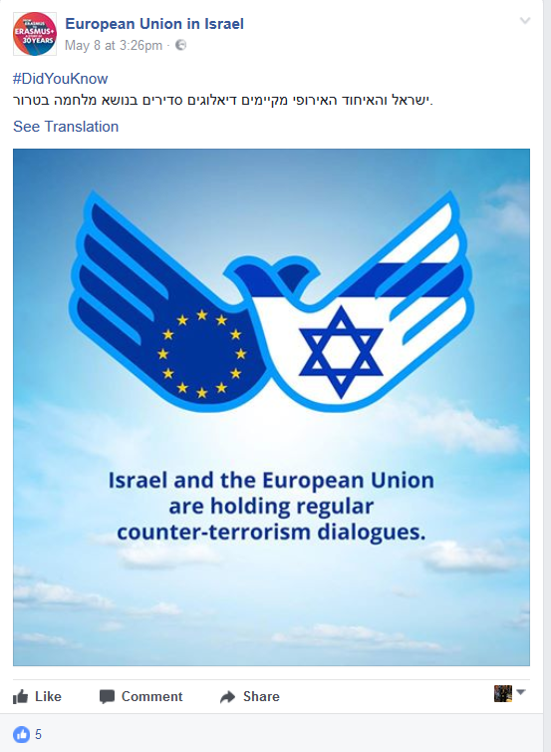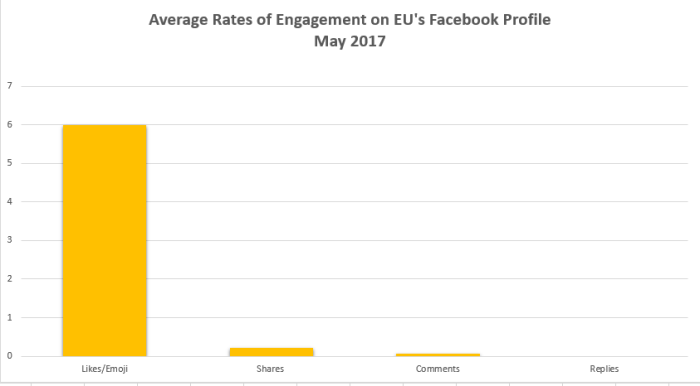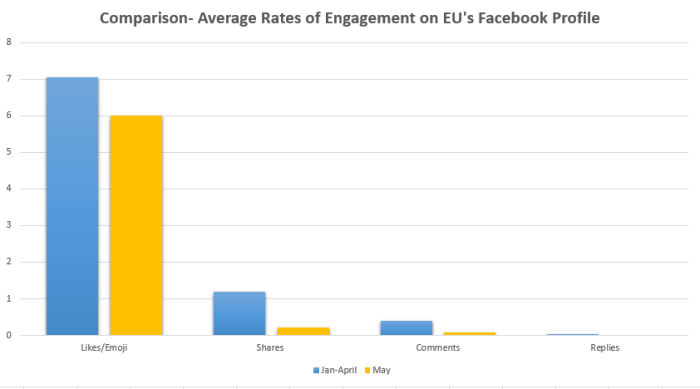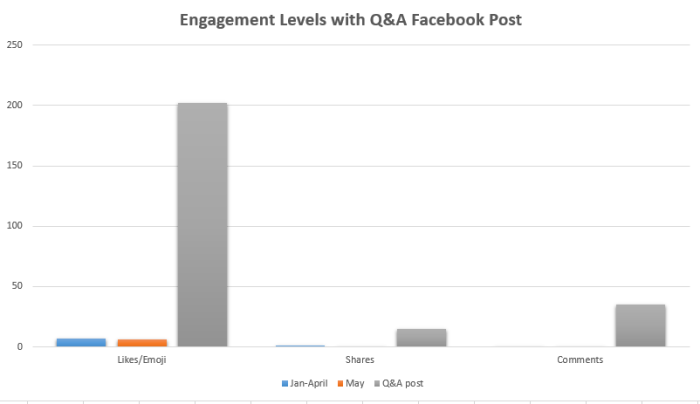digdipblog.com
Introduction
The relationship between Israel and the European Union has been strained for some time. Indeed it is enough to review op-eds published in Israeli newspapers to sense the resentment Israelis hold towards Brussels. This is, in part, a result of three EU policies. The first is the EU’s ongoing critique against Israeli settlements and a proposed EU ban on importing any goods manufactured in Israeli settlements. This ban includes the labelling of Israeli products from settlements. The second policy is the EU’s funding of left-wing civil society organization who, under the current zeitgeist of nationalism, are seen as traitors to the cause of Israeli security. The third policy is the EU’s call for immediate negotiations with the Palestinians towards a two-state solution.
Given the antagonism felt towards the EU in Israel, it is not surprising to learn that the EU’s embassy in Israel has taken to Facebook in order to practice digital public diplomacy. Social media enables embassies to manage their country’s national image, narrate its policies and justify its actions in the global and local arena. Like many of its peers around the world, the embassy may have also migrated to Facebook so as to directly communicate with Israelis thereby bypassing the media and local politicians. Notably, Facebook may be of greater use for digital public diplomacy given that Facebook centres on online interactions while Twitter centres on infromation [sic] sharing.
Recently, the EU’s embassy in Israel has launched a social media campaign which highlights the scope of relations between the EU and Israel in fields such as commerce, scientific collaborations and combating extremism. This campaign is noteworthy as it is a joint venture between the EU’s embassy in Israel and the Israeli embassy to the EU headquarters in Brussels (see images below).

In this post, I evaluate the EU’s new social media campaign and explore whether it may enable the EU to create closer relations with online Israeli publics.
Analysis
Content Analysis– In order to analyse the EU embassy’s new public diplomacy campaign, launched in May, I evaluated all posts published by the embassy since January of 2017. These posts focused on five issue [sic]. The most prevalent issue was scientific and education collaborations between the EU and Israel including investment in Israeli R&D, scholarships for Israeli students attending EU universities and Israeli participation in EU funded scientific programs (e.g., Erasmus). The second most prevalent issue was interactions between the EU Ambassador and Israeli society including Israeli university students, highs school students and embassy support for civil society organizations. The third most prevalent issue included posts celebrating European and Israeli culture. The least prevalent issues dealt were denouncing terror attacks against Israel and advocating the two state solution as the only viable end to the Israeli-Palestinian conflict.
It therefore seems that the EU’s digital public diplomacy strategy focuses on exhibiting the close ties between the EU and Israel, and avoiding contentious issues such as Israeli settlements, boycotting of settlements and the ongoing occupation in the territories.
The social media campaign, launched in May, seems to take a different approach by highlighting other areas in which the EU and Israel collaborate. For instance, one post dealt with the EU’s aid to Israel last year when it combated a string of brush fires. Another post (shown below) deals with EU and Israeli collaboration in the realm of counter-terrorism while yet another posts announces that that the EU has appointed a special coordinator for countering anti-Semitism.

These three posts are likely to resonate with Israeli social media users given Israel’s ongoing struggle against terrorism and a national concern over growing anti-Semitic sentiments in Europe. In addition, by depicting the aid offered to Israel during the fire crisis, the embassy negates the stereotypical view of the EU as an institution that is inherently biased against Israel.
Two additional posts comprising this campaign focused on the scope of trade between the EU and Israel stating that the EU is Israel’s largest trading partner.
Notably, the images used in this campaign seem to have dual meaning. At the explicit level, they depict the close relationship between the EU and Israel as they stand hand in hand. Yet at the implicit level, both hands are also strikingly similar to doves held in midair, the symbol for peace. Thus these images also portray a longing for peace and the EU’s support of peace between Israel and its neighbours.

Engagement Analysis- Next, I attempted to analyse whether the EU’s new social media campaign did in fact resonate with Israeli Facebook users. Thus, I calculated the average levels of user engagement with all EU posts published between January and April of 2017. As can be seen in the graph below, the average EU post receives 7 likes from Israeli users, 1.1 shares and 0.4 comments. Notably, the embassy barley [sic] replies to comments posted by Israeli Facebook users.

These low levels of engagement could suggest that EU posts fail to resonate with Israeli users as they barley [sic] elicit engagement in the form of shares and comments. In addition, these figures suggest that Israeli users do not share EU content with their Facebook friends thus preventing the embassy from increasing its online reach.
The graph below depicts the engagement levels during May of 2017, since the launch of the new social media campaign. As can be seen, engagement levels remain quite low with the average post obtaining 6 likes, 0.2 shares and 0.07 comments.

As the graph below indicates, the new social media campaign actually garners less engagement than regular EU posts published between January and April.

However, there was one Facebook posts that attracted much interest. This post, shown below, invites Israeli users to a Facebook Q&A with the EU Ambassador to Israel. As the graph below demonstrates, this post garnered high levels of engagement when compared with the average EU post.

Summary
This post explored the digitalization of EU public diplomacy activities in Israel. Analysis indicates that EU focuses on non-contentious issues such as scientific collaborations and culture. Employing the prism of public diplomacy, one might argue that the EU is attempting to better its image among Israelis by avoiding areas of conflict.
In addition, this post evaluated a new social media campaign launched jointly by the EU embassy in Israel and Israel’s embassy to the EU. Content analysis suggests that this campaign focuses on issues that might resonate with Israeli social media users including counter-terrorism, anti-Semitism and trade. However, quantitative analysis suggest this campaign fails to elicit higher levels of engagement with Israeli Facebook users.
One explanation for these low levels of engagement might be the EU embassy’s failure to engage in conversations with Israelis. While Israelis seldom comment on EU posts, the EU rarely replies to such comments using social media as a one way medium of communication. As such, the embassy may have yet to create an online community in which contentious and non-contentious issues are discussed. Secondly, it is possible that Israeli users would prefer to engage with the EU embassy on those issues that have driven a wedge between two polities including settlements, the peace process and boycotts. This assumption is strengthened by the fact that the majority of comments published in advance of the Ambassador’s Q&A dealt with these very issues.
It is the high levels of engagement in anticipation of the Ambassador’s Q&A session which demonstrates that Facebook users are eager to converse online with diplomats. And although such publics may be critical, volatile and unpredictable, they are still clamouring to be heard. Thus, it is through conversations and two-way interactions that embassies can best leverage social media to alter their national image among foreign populations.
It is possible that the EU would have garnered more engagement had it shared the content published by the Israeli embassy to the EU as this would have demonstrated the de facto collaboration between the two polities. Next, the Embassy might have held a joint Q&A session with both the EU Ambassador to Israel and his counterpart in Brussels. Lastly, the EU may have launched a more engaging campaign by querying its followers on their interests, needs and concerns and then engaging with these issues.
1 comment:
hermes birkin
yeezy supply
jordan travis scott
jordan 1 high
paul george shoes
yeezy shoes
curry shoes
hermes birkin bag
kyrie 6 shoes
kyrie irving shoes
Post a Comment